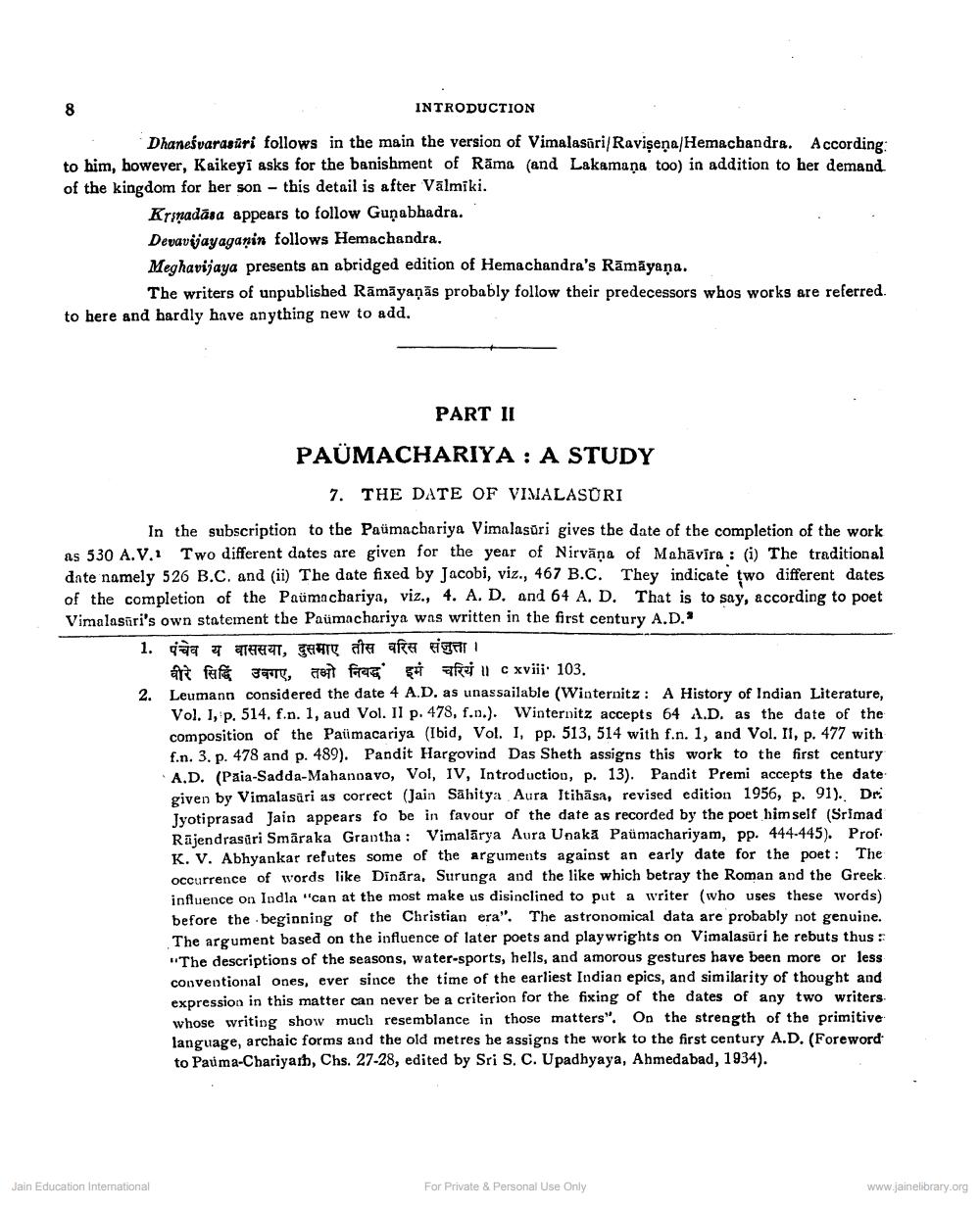________________
8
INTRODUCTION
Dhanesvarasuri follows in the main the version of Vimalasuri/Raviṣena/Hemachandra. According: to him, however, Kaikeyī asks for the banishment of Rāma (and Lakamana too) in addition to her demand. of the kingdom for her son - this detail is after Valmiki.
Kradāsa appears to follow Gunabhadra.
Devavijayaganin follows Hemachandra.
Meghavijaya presents an abridged edition of Hemachandra's Rāmāyaṇa.
The writers of unpublished Rāmāyaṇās probably follow their predecessors whos works are referred. to here and hardly have anything new to add.
PART II
PAÜMACHARIYA : A STUDY
7. THE DATE OF VIMALASURI
In the subscription to the Paümachariya Vimalasūri gives the date of the completion of the work as 530 A.V. Two different dates are given for the year of Nirvana of Mahavira: (i) The traditional date namely 526 B.C. and (ii) The date fixed by Jacobi, viz., 467 B.C. They indicate two different dates of the completion of the Paumachariya, viz., 4. A. D. and 64 A. D. That is to say, according to poet Vimalasiri's own statement the Paümachariya was written in the first century A.D."
1. पंचैव य वाससया, दुसमाए तीस वरिस संजुत्ता ।
वीरे सिद्धिं उवगए, तभो निवद्ध इमं चरियं ॥ cxviii 103.
2. Leumann considered the date 4 A.D. as unassailable (Winternitz: A History of Indian Literature, Vol. I, p. 514. f.n. 1, aud Vol. II p. 478, f.n.). Winternitz accepts 64 A.D. as the date of the composition of the Paimacariya (Ibid, Vol. I, pp. 513, 514 with f.n. 1, and Vol. II, p. 477 with f.n. 3. p. 478 and p. 489). Pandit Hargovind Das Sheth assigns this work to the first century A.D. (Paia-Sadda-Mahannavo, Vol, IV, Introduction, p. 13). Pandit Premi accepts the date given by Vimalasuri as correct (Jain Sahitya Aura Itihasa, revised edition 1956, p. 91). Dr. Jyotiprasad Jain appears fo be in favour of the date as recorded by the poet himself (Srimad Rajendrasuri Smaraka Grantha: Vimalarya Aura Unaka Paümachariyam, pp. 444-445). Prof. K. V. Abhyankar refutes some of the arguments against an early date for the poet: The occurrence of words like Dinara, Surunga and the like which betray the Roman and the Greek influence on Indla "can at the most make us disinclined to put a writer (who uses these words) before the beginning of the Christian era". The astronomical data are probably not genuine. The argument based on the influence of later poets and playwrights on Vimalasuri he rebuts thus: "The descriptions of the seasons, water-sports, hells, and amorous gestures have been more or less conventional ones, ever since the time of the earliest Indian epics, and similarity of thought and expression in this matter can never be a criterion for the fixing of the dates of any two writers. whose writing show much resemblance in those matters". On the strength of the primitive language, archaic forms and the old metres he assigns the work to the first century A.D. (Foreword to Pauma-Chariyarh, Chs. 27-28, edited by Sri S. C. Upadhyaya, Ahmedabad, 1934).
Jain Education International
For Private & Personal Use Only
www.jainelibrary.org




